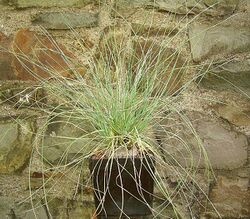Biology:Calibanus
| Calibanus | |
|---|---|

| |
| Calibanus hookeri | |
| Scientific classification | |
| Kingdom: | Plantae |
| Clade: | Tracheophytes |
| Clade: | Angiosperms |
| Clade: | Monocots |
| Order: | Asparagales |
| Family: | Asparagaceae |
| Subfamily: | Nolinoideae |
| Genus: | Calibanus Rose |
| Type species | |
| Calibanus caespitosus (syn of C. hookeri) (Scheidw.) Rose.
| |
Calibanus is a genus of two species of flowering plants, both evergreen succulents from dry areas of northeastern Mexico.[1][2] The APG III classification system places it in the family Asparagaceae, subfamily Nolinoideae (formerly the family Ruscaceae.[3][4]) It was formerly included in the Agavaceae (now Agavoideae) but is now separated from them, for it is polycarpic and dioecious. Its name refers to the monster Caliban, an antagonist in Shakespeare's The Tempest.
Calibanus is dioecious. It is extremely drought-tolerant, with a slow-growing habit. It has tuberous roots called caudices. The caudex can grow to 1m in diameter, with clumps of green-blue, coarse, grasslike, wiry leaves 50 cm long rising from the center and arching down with age. Clusters of tiny, creamy-white flowers, sometimes tinged with pink or purple, are rigid, about 10–20 cm long. Female plants bear globose, ovoid, 3-angled berries with ellipsoid seeds.[5]
-
Leaves of Calibanus hookeri
-
Bark of Calibanus hookeri
Species
- Calibanus glassianus L.Hern. & Zamudio - Guanajuato
- Calibanus hookeri (Lem.) Trel. - San Luis Potosí, Hidalgo
References
- ↑ Kew World Checklist of Selected Plant Families
- ↑ CONABIO. 2009. Catálogo taxonómico de especies de México. 1. In Capital Nat. México. CONABIO, México D.F.
- ↑ Govaerts, R. (1999). World Checklist of Seed Plants 3(1, 2a & 2b): 1-1532. Continental Publishing, Deurne.
- ↑ Chase, M.W.; Reveal, J.L.; Fay, M.F. (2009), "A subfamilial classification for the expanded asparagalean families Amaryllidaceae, Asparagaceae and Xanthorrhoeaceae", Botanical Journal of the Linnean Society 161 (2): 132–136, doi:10.1111/j.1095-8339.2009.00999.x
- ↑ Hernández Sandoval, L. & S. Zamudio Ruíz. 2003. Two new remarkable Nolinaceae from central Mexico. Brittonia 55(3): 226–232.
Wikidata ☰ Q310074 entry
 |



